AudioQuest GO-4 Internal Wire Replacement For The SDA SRS 1.2TL

DarqueKnight
Posts: 6,765
Introduction
After the positive results with Cardas 15.5 AWG Litz wire, I evaluated a higher quality solid core speaker cable to replace the internal wiring of the SDA SRS 1.2TL's.
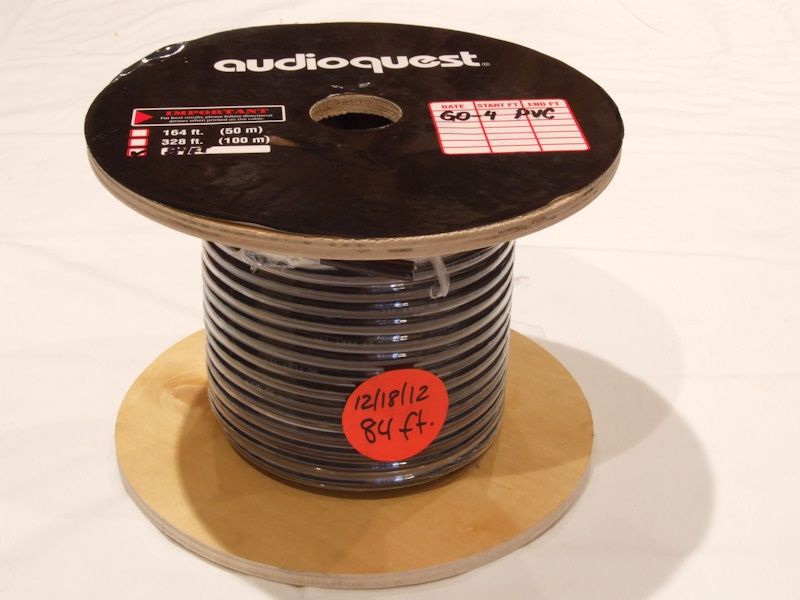
Figure 1. Spool of bulk AudioQuest GO-4 speaker cable.
I ordered 80 feet of GO-4, but AudioQuest threw in an extra 4 feet for free. I used part of the excess to make some nice wire jumpers for my SDA SRS's. GO-4 retails for $15 per dual conductor foot. This is 3X the $5 per dual conductor foot cost of the Cardas 15.5 AWG Litz. Other differences between the two are:
Cardas 15.5 AWG Litz Wire
Wire insulation (dielectric): Polyurethane.
Jacket material: Teflon.
Conductor Count: 48 strands.
Conductor material: 99.9999% pure copper.
AudioQuest GO-4 15 AWG Hyper-Litz Speaker Wire
Wire insulation (dielectric): Nitrogen foamed polyethylene on positive conductors, partially conductive carbon loaded polyethylene on negative conductors.
Jacket material: Polyvinylchloride.
Conductor Count: 2 wires - 1 x 17 AWG, 1 x 20 AWG.
Conductor material: 99.999999% pure copper with highly polished surface.
GO-4 is actually a little smaller than standard sized 15 AWG wire. GO-4's 17 AWG wire has a cross-sectional area of 1.0398 mm^2 and the 20 AWG wire has a cross sectional area of 0.51886 mm^2. This adds up to 1.55866 mm^2, which is 6% less than the 1.65206 mm^2 cross-sectional area of 15 AWG wire. GO-4's cross-sectional area is 6% larger than the Cardas 15.5 AWG wire. GO-4's cross-sectional area is 19% larger than the stock 16 AWG wire (1.30762 mm^2).
Construction Notes
GO-4 cable contains four solid conductors: 17 AWG and 20 AWG positive conductors with red polyethylene insulation and 17 AWG and 20 AWG negative conductors with black polyethylene insulation. The weight and stiffness of GO-4's solid core wire made it much more difficult to work with than the Cardas wire. WBT gold-plated copper quick disconnects were used to terminate the driver and tweeter ends of the wires.
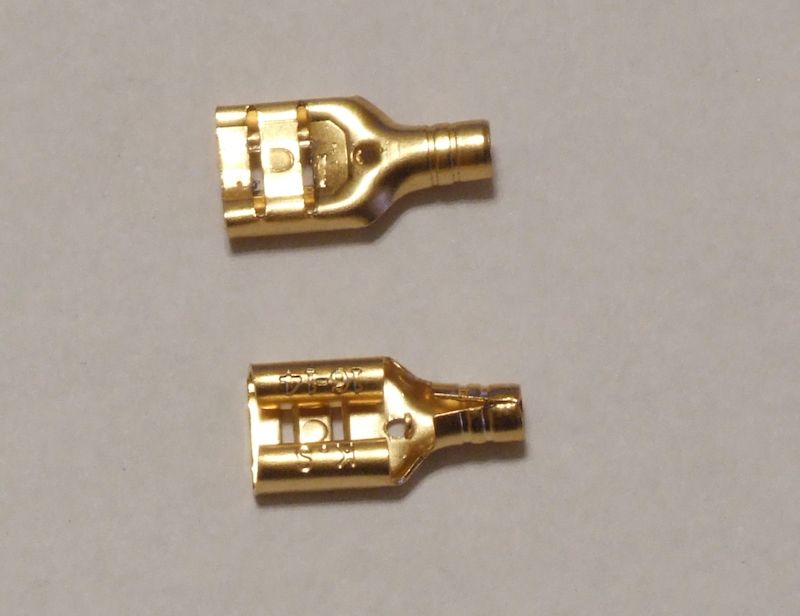
Figure 2. WBT QD25 gold-plated copper quick disconnect.
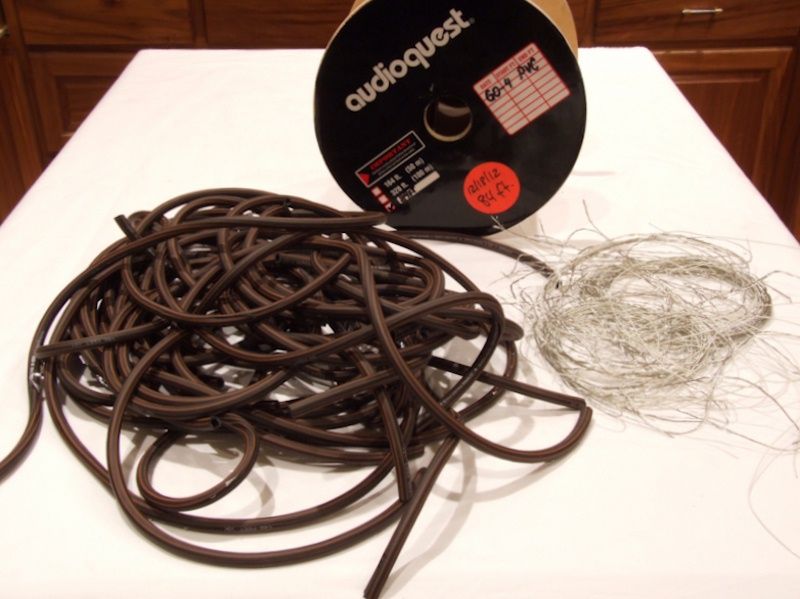
Figure 3. GO-4 trash pile.
I did not use a lot of material that I paid for: foil shield, Dielectric Bias System wires, and the thick PVC outer jacket. I sent an email to AudioQuest asking what percent of GO-4 cable's cost was attributable to the unused parts. They said they didn't know, but that most of the cost of their cables is attributable to the conductors.
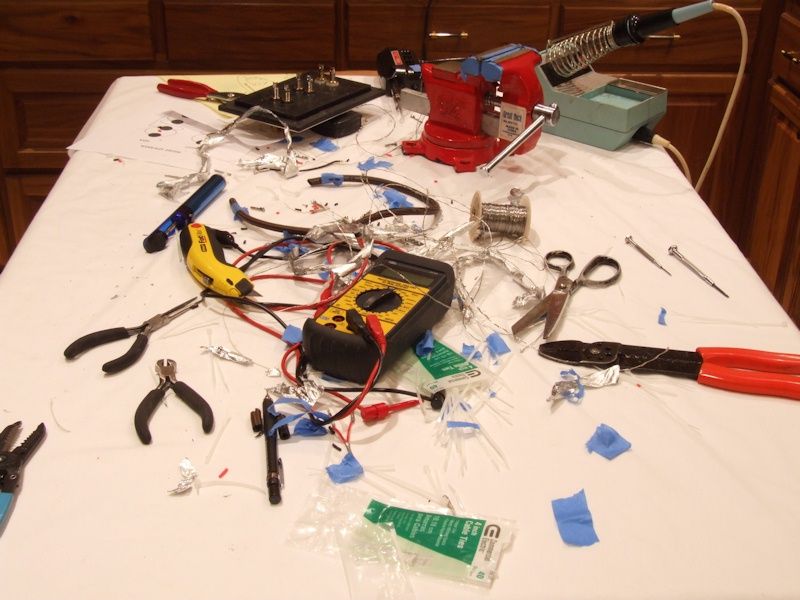
Figure 4. Fun times with cable making.
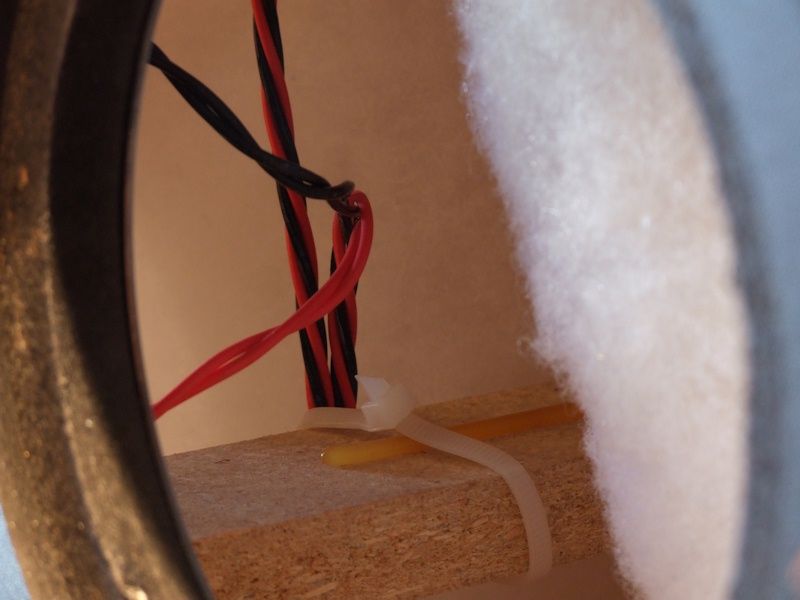
Figure 5. To support the weight of the tweeter wire harness, it was bound to the three cabinet braces in the
tweeter area with cable ties.
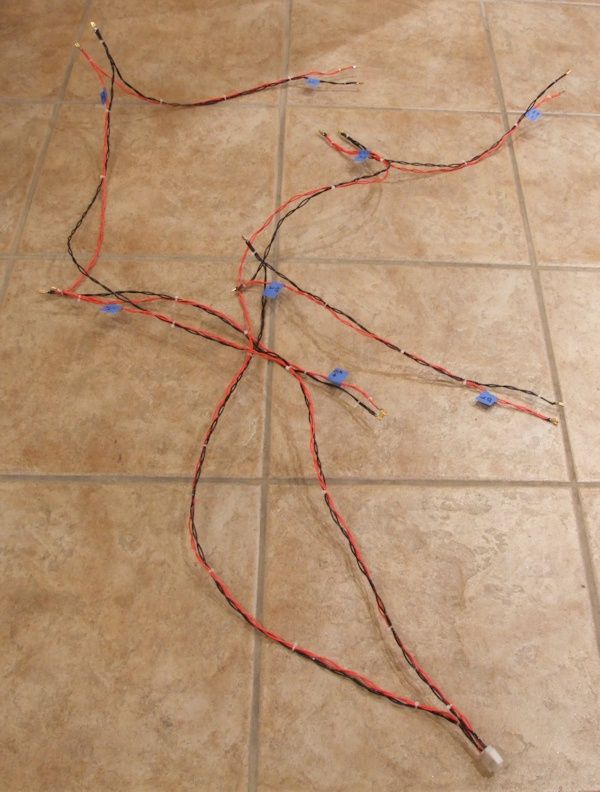
Figure 6. Completed driver wire harness, comprising $300 worth of GO-4 wire.
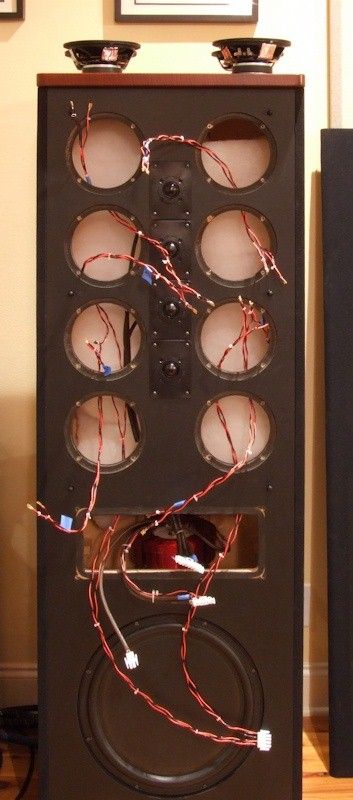
Figure 7. GO-4 wire installed in right SDA SRS 1.2TL.
I wondered why the driver harness wires were so long. The tweeter and binding post harness wires were just long enough to provide a few inches of slack to allow getting your hand between the cabinet and tweeters and between the cabinet and the crossover plate when removing them. The driver harness crossover connector was 15" longer than required and the individual driver wires were 11" longer than required. I maintained the stock driver harness wire lengths because I did not know if there was an electrical design reason for the extra lengths.
In order to prevent stress on the soft metal connection tabs of the drivers and tweeters, the GO-4 wires were gently bent so that the quick disconnects were perfectly aligned and parallel with the driver and tweeter connection tabs. To make sure there was no disconnect slippage during installation of a driver, a mirror and flashlight were used to inspect the bottom of each driver after placement in the baffle. The ends of the wiring harnesses that connected to the crossover board had to be gently bent in such a way that no stress was placed on the board when it was reinstalled in the baffle.
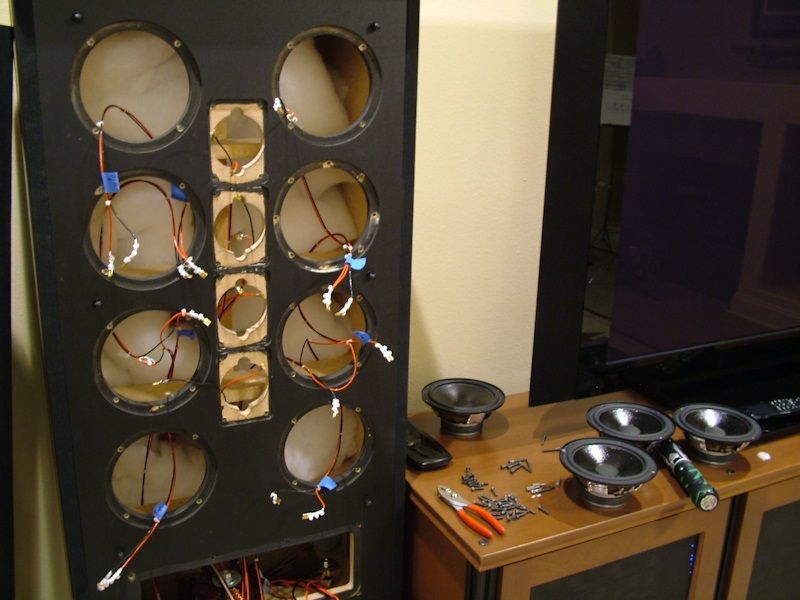
Figure 8. Cardas wire installation in home theater system SDA SRS's
The Cardas driver, tweeter and SDA inductor wire harnesses found a new home in the home theater system's SDA SRS's. I had to reorder the tweeter harness connector pins from T3-T1-T4-T2 (1.2TL) to T1-T2-T3-T4 (SRS). The remaining seven SRS wire harnesses, as well as the wire in my three pairs of CRS+'s, will also be replaced with Cardas wire.
Noise Study
Test signals at 100 Hz and 1000 Hz were passed through a 22" section of the stock wire, a 22" section of Cardas wire and a 22" section of GO-4. The stock wire was the low frequency + wire from the binding post harness that had seen many years of use. The Cardas wire was the low frequency + wire from the binding post harness. It had been conditioned for 96 hours on the Cable Cooker and in use for music play for 220 hours. The GO-4 wire was a 22" section that was conditioned for 24 hours on the Audiodharma Cable Cooker.
It is easier to see differences in the Fast Fourier Transform noise spectrum plots if they are downloaded and viewed in succession.
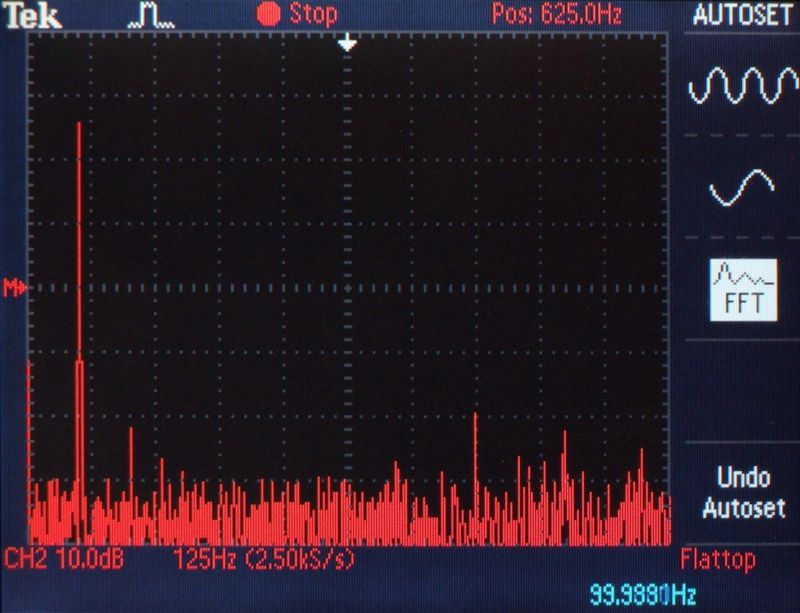
Figure 9. FFT plot of stock wire with 100 Hz test signal.
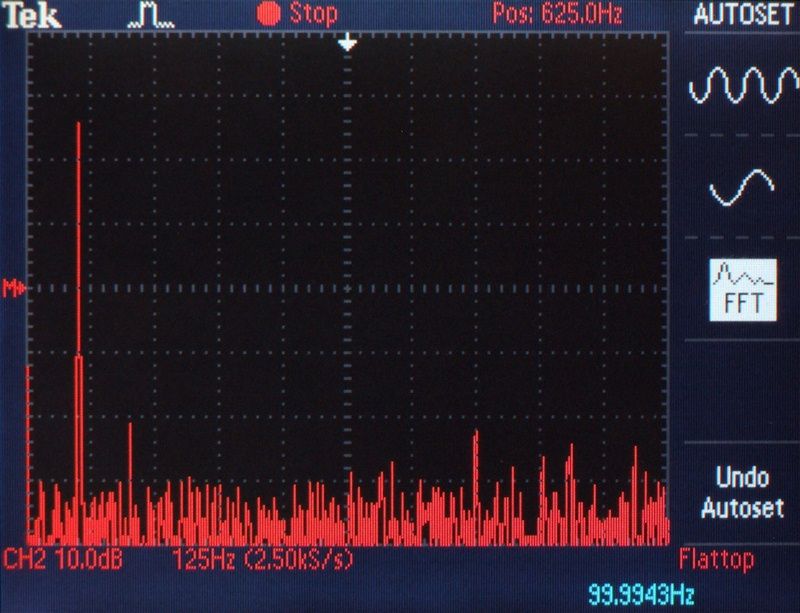
Figure 10. FFT plot of Cardas wire with 100 Hz test signal.
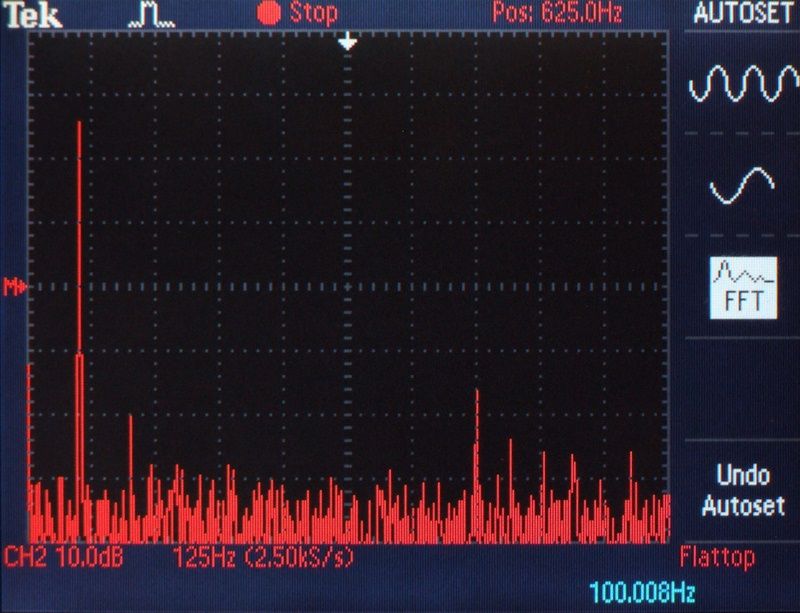
Figure 11. FFT plot of GO-4 wire with 100 Hz test signal.
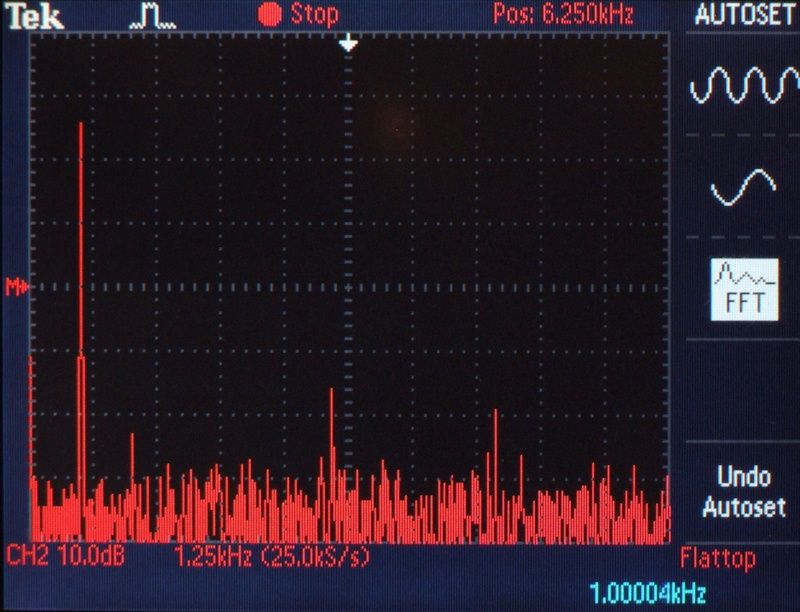
Figure 12. FFT plot of stock wire with 1000 Hz test signal.

Figure 13. FFT plot of Cardas wire with 1000 Hz test signal.
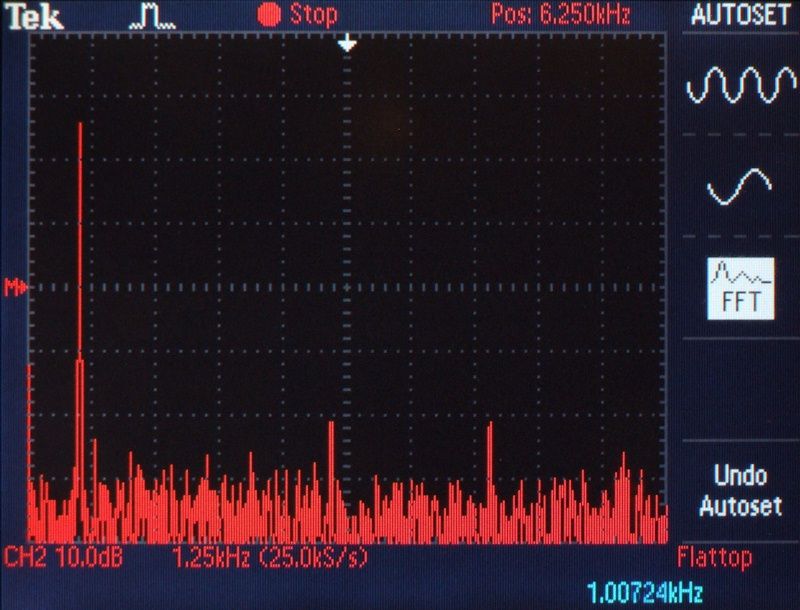
Figure 14. FFT plot of GO-4 wire with 1000 Hz test signal.
There were substantial differences in noise density and amplitude between the stock wire and either the Cardas or GO-4 wire. The noise amplitude and density differences between the Cardas and GO-4 wire were not substantial. The GO-4 showed slightly less noise around the test signal frequencies than the Cardas.
Burn In
The GO-4 wire was burned in with music play over 148 hours. However, no changes were heard after 75 hours. I did not use the Cable Cooker for two reasons: 1. I wanted to hear the changes in the wire as it burned in. 2. GO-4 is difficult to handle and I did not want to do multiple cook-install-listen-remove-cook cycles.
Listening Evaluation
The right speaker was completely rewired with GO-4 and compared to the Cardas-wired left speaker. My initial impression after comparing the brand new, unbroken in GO-4 on the right to the broken in Cardas wire on the left was that the GO-4 was about 10% better in imaging properties, clarity and detail. There was a slight blurring of bass detail and articulation that went away after 4 hours of music play.
After the left speaker was rewired, both speakers were burned in for 148 hours straight using a combination of CD player and radio tuner. I did not hear any improvements after the 75th hour. During listening sessions, up to the 75th hour, I was continually struck by new sounds in familiar evaluation media that I did not remember and that I had not documented on previous sound stage evaluation charts or listening notes. I used the CD player's "rewind" button many times to restart a song intro or to replay a passage that had a sound image that was new, or much different in loudness, clarity or character.
On simply miked recordings with few sound images, the GO-4 showed only a small to modest improvement in detail and clarity over the Cardas wire, but showed modest to significant improvements in image weight, ambient effects, bass articulation and bass detail. On complex orchestral and choral recordings, and on recordings that had complex percussion tracks, the GO-4 earned its 3X cost premium and left the Cardas in the dust with significantly more resolution, enhanced depth and enhanced holographic three-dimensionality. Spatial improvements were more apparent with analog media than with digital (CD and SACD).
The GO-4 was significantly better in tactile sensation on all recordings. There was more vibration not only against my body, but also coming through the floor and the listening seat. The increase in air pressure and floor vibration was noticeable in rooms adjacent to the listening room. In summary, GO-4 provided "thicker" and clearer sound. Such good wire and Such Good Sound.
After the positive results with Cardas 15.5 AWG Litz wire, I evaluated a higher quality solid core speaker cable to replace the internal wiring of the SDA SRS 1.2TL's.

Figure 1. Spool of bulk AudioQuest GO-4 speaker cable.
I ordered 80 feet of GO-4, but AudioQuest threw in an extra 4 feet for free. I used part of the excess to make some nice wire jumpers for my SDA SRS's. GO-4 retails for $15 per dual conductor foot. This is 3X the $5 per dual conductor foot cost of the Cardas 15.5 AWG Litz. Other differences between the two are:
Cardas 15.5 AWG Litz Wire
Wire insulation (dielectric): Polyurethane.
Jacket material: Teflon.
Conductor Count: 48 strands.
Conductor material: 99.9999% pure copper.
AudioQuest GO-4 15 AWG Hyper-Litz Speaker Wire
Wire insulation (dielectric): Nitrogen foamed polyethylene on positive conductors, partially conductive carbon loaded polyethylene on negative conductors.
Jacket material: Polyvinylchloride.
Conductor Count: 2 wires - 1 x 17 AWG, 1 x 20 AWG.
Conductor material: 99.999999% pure copper with highly polished surface.
GO-4 is actually a little smaller than standard sized 15 AWG wire. GO-4's 17 AWG wire has a cross-sectional area of 1.0398 mm^2 and the 20 AWG wire has a cross sectional area of 0.51886 mm^2. This adds up to 1.55866 mm^2, which is 6% less than the 1.65206 mm^2 cross-sectional area of 15 AWG wire. GO-4's cross-sectional area is 6% larger than the Cardas 15.5 AWG wire. GO-4's cross-sectional area is 19% larger than the stock 16 AWG wire (1.30762 mm^2).
Construction Notes
GO-4 cable contains four solid conductors: 17 AWG and 20 AWG positive conductors with red polyethylene insulation and 17 AWG and 20 AWG negative conductors with black polyethylene insulation. The weight and stiffness of GO-4's solid core wire made it much more difficult to work with than the Cardas wire. WBT gold-plated copper quick disconnects were used to terminate the driver and tweeter ends of the wires.

Figure 2. WBT QD25 gold-plated copper quick disconnect.

Figure 3. GO-4 trash pile.
I did not use a lot of material that I paid for: foil shield, Dielectric Bias System wires, and the thick PVC outer jacket. I sent an email to AudioQuest asking what percent of GO-4 cable's cost was attributable to the unused parts. They said they didn't know, but that most of the cost of their cables is attributable to the conductors.

Figure 4. Fun times with cable making.

Figure 5. To support the weight of the tweeter wire harness, it was bound to the three cabinet braces in the
tweeter area with cable ties.

Figure 6. Completed driver wire harness, comprising $300 worth of GO-4 wire.

Figure 7. GO-4 wire installed in right SDA SRS 1.2TL.
I wondered why the driver harness wires were so long. The tweeter and binding post harness wires were just long enough to provide a few inches of slack to allow getting your hand between the cabinet and tweeters and between the cabinet and the crossover plate when removing them. The driver harness crossover connector was 15" longer than required and the individual driver wires were 11" longer than required. I maintained the stock driver harness wire lengths because I did not know if there was an electrical design reason for the extra lengths.
In order to prevent stress on the soft metal connection tabs of the drivers and tweeters, the GO-4 wires were gently bent so that the quick disconnects were perfectly aligned and parallel with the driver and tweeter connection tabs. To make sure there was no disconnect slippage during installation of a driver, a mirror and flashlight were used to inspect the bottom of each driver after placement in the baffle. The ends of the wiring harnesses that connected to the crossover board had to be gently bent in such a way that no stress was placed on the board when it was reinstalled in the baffle.

Figure 8. Cardas wire installation in home theater system SDA SRS's
The Cardas driver, tweeter and SDA inductor wire harnesses found a new home in the home theater system's SDA SRS's. I had to reorder the tweeter harness connector pins from T3-T1-T4-T2 (1.2TL) to T1-T2-T3-T4 (SRS). The remaining seven SRS wire harnesses, as well as the wire in my three pairs of CRS+'s, will also be replaced with Cardas wire.
Noise Study
Test signals at 100 Hz and 1000 Hz were passed through a 22" section of the stock wire, a 22" section of Cardas wire and a 22" section of GO-4. The stock wire was the low frequency + wire from the binding post harness that had seen many years of use. The Cardas wire was the low frequency + wire from the binding post harness. It had been conditioned for 96 hours on the Cable Cooker and in use for music play for 220 hours. The GO-4 wire was a 22" section that was conditioned for 24 hours on the Audiodharma Cable Cooker.
It is easier to see differences in the Fast Fourier Transform noise spectrum plots if they are downloaded and viewed in succession.

Figure 9. FFT plot of stock wire with 100 Hz test signal.

Figure 10. FFT plot of Cardas wire with 100 Hz test signal.

Figure 11. FFT plot of GO-4 wire with 100 Hz test signal.

Figure 12. FFT plot of stock wire with 1000 Hz test signal.

Figure 13. FFT plot of Cardas wire with 1000 Hz test signal.

Figure 14. FFT plot of GO-4 wire with 1000 Hz test signal.
There were substantial differences in noise density and amplitude between the stock wire and either the Cardas or GO-4 wire. The noise amplitude and density differences between the Cardas and GO-4 wire were not substantial. The GO-4 showed slightly less noise around the test signal frequencies than the Cardas.
Burn In
The GO-4 wire was burned in with music play over 148 hours. However, no changes were heard after 75 hours. I did not use the Cable Cooker for two reasons: 1. I wanted to hear the changes in the wire as it burned in. 2. GO-4 is difficult to handle and I did not want to do multiple cook-install-listen-remove-cook cycles.
Listening Evaluation
The right speaker was completely rewired with GO-4 and compared to the Cardas-wired left speaker. My initial impression after comparing the brand new, unbroken in GO-4 on the right to the broken in Cardas wire on the left was that the GO-4 was about 10% better in imaging properties, clarity and detail. There was a slight blurring of bass detail and articulation that went away after 4 hours of music play.
After the left speaker was rewired, both speakers were burned in for 148 hours straight using a combination of CD player and radio tuner. I did not hear any improvements after the 75th hour. During listening sessions, up to the 75th hour, I was continually struck by new sounds in familiar evaluation media that I did not remember and that I had not documented on previous sound stage evaluation charts or listening notes. I used the CD player's "rewind" button many times to restart a song intro or to replay a passage that had a sound image that was new, or much different in loudness, clarity or character.
On simply miked recordings with few sound images, the GO-4 showed only a small to modest improvement in detail and clarity over the Cardas wire, but showed modest to significant improvements in image weight, ambient effects, bass articulation and bass detail. On complex orchestral and choral recordings, and on recordings that had complex percussion tracks, the GO-4 earned its 3X cost premium and left the Cardas in the dust with significantly more resolution, enhanced depth and enhanced holographic three-dimensionality. Spatial improvements were more apparent with analog media than with digital (CD and SACD).
The GO-4 was significantly better in tactile sensation on all recordings. There was more vibration not only against my body, but also coming through the floor and the listening seat. The increase in air pressure and floor vibration was noticeable in rooms adjacent to the listening room. In summary, GO-4 provided "thicker" and clearer sound. Such good wire and Such Good Sound.
Proud and loyal citizen of the Digital Domain and Solid State Country!
Post edited by DarqueKnight on
Comments
-
Great write-up, as usual! It makes sense that if 10' of wire on the outside of speakers makes a difference, then so should 10' of wire INSIDE the speaker. Thanks for sharing your results.
-
And my wallet is soon to be lighter!!!
-
Very, very cool. I don't know that I would perform this mod, only because of time, but maybe someday for sure.
Thanks DK, very professional. -
I knew DK wasn't done, very nice as usual.
-
I purchased Neotech 18AWG solid-core wiring sometime ago for my 1.2TL speakers. I wonder how it will sound compared to DKs results.
I see braiding of wires in the near future.Statistics show that 98% of us will die at some point in our lifetime.
The other 2% will work for WalMart. -
PolkMaster1 wrote: »I purchased Neotech 18AWG solid-core wiring sometime ago for my 1.2TL speakers.
Why did you choose 18 AWG wire? It is 45% smaller than the stock 16 AWG.Proud and loyal citizen of the Digital Domain and Solid State Country! -
PolkMaster1 wrote: »I purchased Neotech 18AWG solid-core wiring sometime ago for my 1.2TL speakers. I wonder how it will sound compared to DKs results.
I see braiding of wires in the near future.DarqueKnight wrote: »Why did you choose 18 AWG wire? It is 45% smaller than the stock 16 AWG.
I have used Neotech solid core wire for carrying signals. It sounds very nice. Ray is correct in asking why use a smaller guage than the stock wire? I would get the 16 AWG instead. I know this wire is expensive as well, but if you are going to rewire your speakers, I would do it right. (Right being at least the same guage as the stock Polk wire).
Thanks Ray for the write up. I will need to do this upgrade eventually since you found nice results. I'm always up for heavier image weight, better imaging, and improved clarity.
So when are you upgrading to Clarity Cap ESA's and Duelund resistors Ray? :cheesygrin:
:cheesygrin: 
Taken from a recent Audioholics reply regarding "Club Polk" and Polk speakers:
"I'm yet to hear a Polk speaker that merits more than a sentence and 60 seconds discussion."
My response is: If you need 60 seconds to respond in one sentence, you probably should't be evaluating Polk speakers.....
"Green leaves reveal the heart spoken Khatru"- Jon Anderson
"Have A Little Faith! And Everything You'll Face, Will Jump From Out Right On Into Place! Yeah! Take A Little Time! And Everything You'll Find, Will Move From Gloom Right On Into Shine!"- Arthur Lee -
So when are you upgrading to Clarity Cap ESA's and Duelund resistors Ray?
I don't know. Those Coke can sized Clarity Caps and extra long cinnamon stick Duelund resistors would make my crossovers ugly.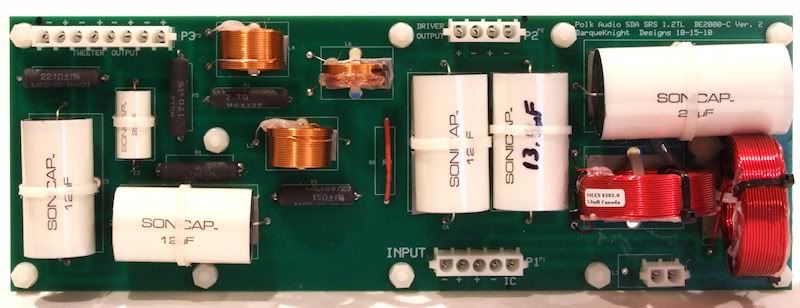 Proud and loyal citizen of the Digital Domain and Solid State Country!
Proud and loyal citizen of the Digital Domain and Solid State Country! -
DarqueKnight wrote: »I don't know. Those Coke can sized Clarity Caps and extra long cinnamon stick Duelund resistors would make my crossovers ugly.

Yeah, you're right about that Ray. But, man will they sound sweet. If you like neutral sound with a slight warmth and detail, transparency, imaging and soundstage improved significantly (compared to Sonicaps/Mills). You will never regret making your crossovers ugly Ray. Guaranteed.
Taken from a recent Audioholics reply regarding "Club Polk" and Polk speakers:
"I'm yet to hear a Polk speaker that merits more than a sentence and 60 seconds discussion."
My response is: If you need 60 seconds to respond in one sentence, you probably should't be evaluating Polk speakers.....
"Green leaves reveal the heart spoken Khatru"- Jon Anderson
"Have A Little Faith! And Everything You'll Face, Will Jump From Out Right On Into Place! Yeah! Take A Little Time! And Everything You'll Find, Will Move From Gloom Right On Into Shine!"- Arthur Lee -
I'm curious , when you used the Go4 for internal wiring , why did you strip off the Insulation? I believe you might have got an even better result if you would have left it on. Reason , Audioquest is completely anal about the relationship of the conductors inside the jacket. They call it Star Quad , here is a quote from the website explaining exaclty what I learned about this technology.
STAR-QUAD GEOMETRY: The relationship between conductors defines a cable's most basic electrical values (capacitance and inductance). However, even when those variables are kept in a reasonable balance, the relationship between conductors can be varied in ways that greatly affect the sound. The Star-Quad construction of GO-4 allows for significantly better dynamic contrast and information intelligibility than if the same conductors were run in parallel.
So I'm wondering if you would have got even better results leaving the jacket on. I'm sure it would have been much harder to work with as I'm thinking this is exactly why you stripped it all off. I believe you could have used some type of tacks to support the weight inside the speaker cabinet so it didn't put un necessary pressure on the driver terminals. I know its to late now but I wonder.
Nice job by the way , Cardas and Audioquest are the perfect companies to compare to each other. They both hold signal transfer to the highest standard. The more I learn about Cardas , the more I really respect them. I have a pair of Crosslinks in my system right now which I replaced some Audioquest Flx 14/2 on my main channels and so far I'm pleased with the overall performance of the Cardas.
You inspire me to rip apart my speakers and go internal , If I do , I'm gonna leave the jacket on and deal with the difficulties of having the extra weight inside. I feel it might be worth it. I might even buy enough to compare both ways. What do you think?Dan
My personal quest is to save to world of bad audio, one thread at a time. -
Sorry double postDan
My personal quest is to save to world of bad audio, one thread at a time. -
Jesus Ray... my poor wallet man. :razz:
As we spoke briefly a while back about this adventure, it's nice to see positive results rather than no benefits. Another thing to do down the road now. -
DarqueKnight wrote: »Why did you choose 18 AWG wire? It is 45% smaller than the stock 16 AWG.
Each speaker will receive a four conductor braid. Two conductors per terminal. The braided technique reduces reduce RFI that can be picked up and transfered to the speaker.Statistics show that 98% of us will die at some point in our lifetime.
The other 2% will work for WalMart. -
So when are you upgrading to Clarity Cap ESA's and Duelund resistors Ray?
 :cheesygrin:
:cheesygrin:
We are all staying tuned for this as I am fairly certian that Ray will go down this path when he is more dedicated to audio than he is now. I placed an order the other day with VR3 for Clarity Cap ESA with Mundorf MR Resistors. I am tempted to go Duelund Carbon Cast Silver, but given the size, it may be too difficult to work with, given the miniature explosive size caps the Clarity Caps are.
I have my work cut out for me since I bonded my sonic caps to the PCB with hot glue and trying to take them apart will be a challenge.Statistics show that 98% of us will die at some point in our lifetime.
The other 2% will work for WalMart. -
Let me preface this by saying that I respect the enormous amount of commitment, time, money, effort, and enthusiasm it takes to develop and create these improvements, measure differences, verify differences with actual 'scope patterns, and DOCUMENT THE WHOLE EFFORT for others to learn from.DarqueKnight wrote: »Why did you choose 18 AWG wire? It is 45% smaller than the stock 16 AWG.
THANK YOU.
Someday, when you're more dedicated to audio than you are now perhaps you could humor me: I'd just love to see how 12-gauge THHN stranded or solid-core (at fifty cents a foot) stacks up against Insane Profit Margin audiophile cable in ~15--16 gauge.
perhaps you could humor me: I'd just love to see how 12-gauge THHN stranded or solid-core (at fifty cents a foot) stacks up against Insane Profit Margin audiophile cable in ~15--16 gauge.
For that matter, even mil-spec silver-plated-copper conductor/Teflon insulation at <$3 per foot in 12 or 14 gauge.
Again, thanks for all you do for this forum. -
I have my work cut out for me since I bonded my sonic caps to the PCB with hot glue and trying to take them apart will be a challenge.
The hot glue comes right off.Political Correctness'.........defined
"A doctrine fostered by a delusional, illogical minority and rabidly promoted by an unscrupulous mainstream media, which holds forth the proposition that it is entirely possible to pick up a t-u-r-d by the clean end."
President of Club Polk -
One additional detail regarding the size of the Clarity Cap ESRs - it can present a fitting challenge for those of us using Solen 14mH Inductors when we try to fit the PC board back into our in our 1.2TLs.
The Solen inductor introduced additional bracing inside the cabinets. The inductor is sitting on the brace above the PR, one inch forward from the back wall. Additional support was added next to the bracing on the left and right sides using a 2X4 cut down to size to fit inside the speakers. Gorrilla Glue was used to hold the additional bracing in place. A 1X1 placed on top of the bracing, at the very back and about an inch from very front cabinet walls was also used going across the three boards to bond all three boards in place, giving it additional strength to the bracing.
7 months after this mod, the additional bracing support still holds strong. Gotta love Gorilla Glue.Statistics show that 98% of us will die at some point in our lifetime.
The other 2% will work for WalMart. -
I'm not sure how cabinet bracing, caps and inductors pertains to the original subject matter, but since you went there. Did you calculate the reduction of cabinet volume before adding such a massive amount of bracing?
As for Gorilla Glue, it's nasty stuff and should be removed from the market, IMO.Political Correctness'.........defined
"A doctrine fostered by a delusional, illogical minority and rabidly promoted by an unscrupulous mainstream media, which holds forth the proposition that it is entirely possible to pick up a t-u-r-d by the clean end."
President of Club Polk -
As for Gorilla Glue, it's nasty stuff and should be removed from the market, IMO.
This^^^^ It's the worst IMO -
I wish I had the free time to do these upgrades to my speakers

Be careful what you wish for. The free time you want can be both a blessing-to your ears, and a curse-to your wallet.I guess I need to buy another pair that have already been upgraded.
Yeah, well , good luck with that. You know how difficult it is to find large SDA's in good condition in stock form.I'm curious , when you used the Go4 for internal wiring , why did you strip off the Insulation? I believe you might have got an even better result if you would have left it on. Reason , Audioquest is completely anal about the relationship of the conductors inside the jacket.
So I'm wondering if you would have got even better results leaving the jacket on. I'm sure it would have been much harder to work with as I'm thinking this is exactly why you stripped it all off. I believe you could have used some type of tacks to support the weight inside the speaker cabinet so it didn't put un necessary pressure on the driver terminals. I know its to late now but I wonder.
You inspire me to rip apart my speakers and go internal , If I do , I'm gonna leave the jacket on and deal with the difficulties of having the extra weight inside. I feel it might be worth it. I might even buy enough to compare both ways. What do you think?
I wondered about this myself. That is why I did a very time-consuming four iterations of the install:
1. With the PVC jacket intact and a foamed PE wire (red) and carbon loaded PE (black) wire (black) running to positive and negative terminals.
2. With the PVC jacket intact and both foamed PE wires (red) running to positive terminals and both carbon loaded PE wires running to the negative terminals.
3. With the PVC jacket off and a foamed PE wire (red) and carbon loaded PE (black) wire (black) running to positive and negative terminals.
4. With the PVC jacket off and both foamed PE wires (red) running to positive terminals and both carbon loaded PE wires running to the negative terminals.
All four trials were done with the tweeter, SAD inductor and binding post harnesses. I could not do PVC jacket on/off trials with the driver harness because the complex series/parallel configuration, with many unequal wire sections, meant that I could not use intact cable sections.
You are correct that the thick (3/16") PVC jacket did make the cables more difficult to handle. That is why I removed them.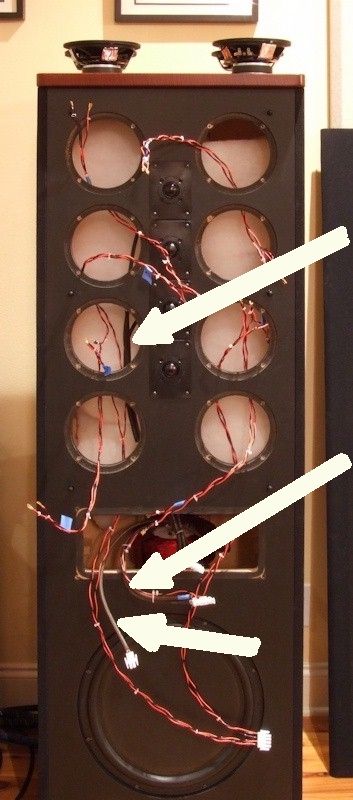
Fgure 15. Arrows point to tweeter and SDA inductorwire harnesses installed with PVC jacket intact.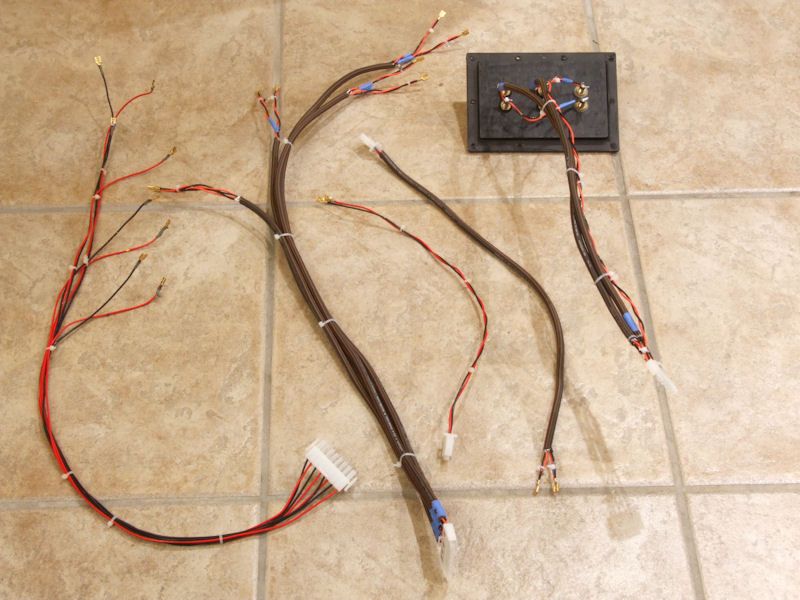
Figure 16. Left to right: Cardas tweeter harness, GO-4 tweeter harness with PVC jacket, Cardas SDA inductor
harness, GO-4 SDA inductor harness with PVC jacket, GO-4 binding post harness with PVC jacket.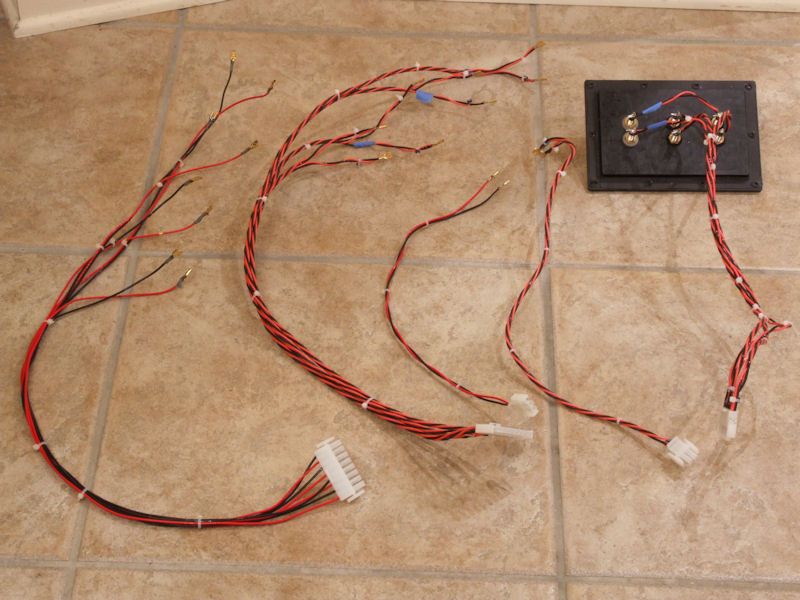
Figure 17. Left to right: Cardas tweeter harness, GO-4 tweeter harness without jacket, Cardas SDA inductor
harness, GO-4 SDA inductor harness without jacket, GO-4 binding post harness with PVC jacket.
I heard no difference between the PVC jacket being on or off. There was a small loss of detail when mixing foamed PE and carbon loaded PE conductors at the same terminal.
As shown in figures 5 and 6 of the first post, item 4 was the final configuration.Someday, when you're more dedicated to audio than you are now perhaps you could humor me: I'd just love to see how 12-gauge THHN stranded or solid-core (at fifty cents a foot) stacks up against Insane Profit Margin audiophile cable in ~15--16 gauge.
perhaps you could humor me: I'd just love to see how 12-gauge THHN stranded or solid-core (at fifty cents a foot) stacks up against Insane Profit Margin audiophile cable in ~15--16 gauge.
I did something similar a while ago. I compared speaker cables made from Home Depot 6 gauge THHN copper to three audiophile speaker cables. The discussion of the Home Depot cables is here:
Mystery-Cable-Theater
I could not quicky find the thread where I compared the Home Depot cable to three audiophile cables. A summary of results is attached to this post.Proud and loyal citizen of the Digital Domain and Solid State Country! -
Did you calculate the reduction of cabinet volume before adding such a massive amount of bracing?
No. I calculated the reduction of cabinet volume when adding the bracing and inductor combined. It is not much.
Why did Home Depot have to place the Gorilla Glue next to the trusty Elmers Carpenter Glue? (It is labeled as Gorilla Wood Glue.)As for Gorilla Glue, it's nasty stuff and should be removed from the market, IMO.Statistics show that 98% of us will die at some point in our lifetime.
The other 2% will work for WalMart. -
I'm sure you did but did you pay attention to the directional flow? When you striped off the outer jackets , did you keep signal flow in tact? Reason , Audioquest mills the wire in one direction , this same direction is the way it's supposed to send the signal from amp to speaker.Dan
My personal quest is to save to world of bad audio, one thread at a time. -
PolkMaster1 wrote: »I have my work cut out for me since I bonded my sonic caps to the PCB with hot glue and trying to take them apart will be a challenge.
Try this Hot Glue & How to remove it.The hot glue comes right off.
There's a right tool for every job. :razz:
:razz:
DK, I don't know how to break it to you but according to WBT's Website the WBT QD25 quick disconnect is Gold plated brass, not copper sorry.“The two most important days in your life are the day you are born and the day you find out why.” ~ Mark Twain -
I'm sure you did but did you pay attention to the directional flow? When you striped off the outer jackets , did you keep signal flow in tact? Reason , Audioquest mills the wire in one direction , this same direction is the way it's supposed to send the signal from amp to speaker.
I did. AQ was nice enough to print direction arrows on the outer PVC jackt and on the insulation of the positive and negative conductors.
Figure 18. GO-4 negative conductors.
Figure 19. GO-4 positive conductors.
Figure 20. GO-4 outer jacket.DK, I don't know how to break it to you but according to WBT's Website the WBT QD25 quick disconnect is Gold plated brass, not copper sorry.
Thanks. I am more inclined to believe WBT's website. I wonder if they were made of copper at one time or if this is misprint?:
http://www.hndme.com/productcart/pc/viewPrd.asp?idcategory=51&idproduct=1894
I sent an email to WBT requesting clarification.Proud and loyal citizen of the Digital Domain and Solid State Country! -
According to handmade electronics' website the WBT 710E quick connect they sell is gold plated copper: http://www.hndme.com/productcart/pc/viewPrd.asp?idcategory=51&idproduct=1894
I'd ask about this one too.
edit: I didn't notice the link you had in # 26 - same product. I wonder why Handmade calls it by a different product number in the caption?"Science is suppose to explain observations not dismiss them as impossible" - Norm on AA; 2.3TL's w/sonicaps/mills/jantzen inductors, Gimpod's boards, Lg Solen SDA inductors, RD-0198's, MW's dynamatted, Armaflex speaker gaskets, H-nuts, brass spikes, Cardas CCGR BP's, upgraded IC Cable, Black Hole Damping Sheet strips, interior of cabinets sealed with Loctite Power Grab, AI-1 interface with 1000VA A-L transformer -
While I am waiting on some Cardas wire to arrive so that I can finish rewiring my SDA SRS's, I used some of the leftover GO-4 to make some jumpers.

Working with the Cardas wire won't seem like such a chore after dealing with the GO-4 solid core wire.:twisted:
When Soniccraft has another sale, I'll order enough Cardas wire for my three pairs of CRS+'s.Proud and loyal citizen of the Digital Domain and Solid State Country! -
If Sonicraft has business sense, everything you ordered would be 70% off, provided you wrote an article about it.DarqueKnight wrote: »When Soniccraft has another sale, I'll order enough Cardas wire for my three pairs of CRS+'s. -
I also use the Audioquest Bananas , they are fantastic. Nice jumpers my man.DarqueKnight wrote: »While I am waiting on some Cardas wire to arrive so that I can finish rewiring my SDA SRS's, I used some of the leftover GO-4 to make some jumpers.
Working with the Cardas wire won't seem like such a chore after dealing with the GO-4 solid core wire.:twisted:
When Soniccraft has another sale, I'll order enough Cardas wire for my three pairs of CRS+'s.Dan
My personal quest is to save to world of bad audio, one thread at a time. -
So when are you upgrading to Clarity Cap ESA's and Duelund resistors Ray?
 :cheesygrin:
:cheesygrin:
I placed an order today for ten Duelund CAST Silver/Carbon resistors to replace the Mills in my 1.2TL's. I ordered the long 10 watt version with extra long leads ($6.70 extra per resistor). Dueland said the long 10W resistors offered a small improvement performance over the shorter 5W versions. I plan to mount them on the back side of the board.If you like neutral sound with a slight warmth and detail, transparency, imaging and soundstage improved significantly (compared to Sonicaps/Mills). Guaranteed.
We'll see how it goes with the Duelunds.Proud and loyal citizen of the Digital Domain and Solid State Country! -
I haven't personally heard the Duelund's with the Sonicaps (only the Clarity Cap ESA's), but you should get an improvement with the transparency and detail due the Duelund's Ray. Definately let us know how it goes. If you like the Duelund's, you will also the enjoy the improvement the Clarity Cap ESA's bring as well. The Clarity Cap's are a little more transparent, have much better imaging, detail, and soundstage.

Taken from a recent Audioholics reply regarding "Club Polk" and Polk speakers:
"I'm yet to hear a Polk speaker that merits more than a sentence and 60 seconds discussion."
My response is: If you need 60 seconds to respond in one sentence, you probably should't be evaluating Polk speakers.....
"Green leaves reveal the heart spoken Khatru"- Jon Anderson
"Have A Little Faith! And Everything You'll Face, Will Jump From Out Right On Into Place! Yeah! Take A Little Time! And Everything You'll Find, Will Move From Gloom Right On Into Shine!"- Arthur Lee






